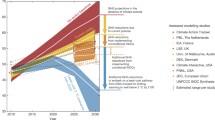Abstract
By 15 December 2015, 187 countries had submitted their Intended Nationally Determined Contributions (INDCs) summarising their climate actions after 2020 in the context of the Paris Agreement. We used a unified framework to assess the mitigation components of INDCs covering 105 countries (representing approximately 91 % of global greenhouse gas emissions in 2012) with a special focus on the G20 economies. We estimated the required reduction effort by comparing the greenhouse gas emission targets implied by the INDCs with the projected levels resulting from current mitigation policies. The resulting projected global reduction effort amounts to approximately 4–6 GtCO2eq by 2030, of which the G20 economies are responsible for the largest share, in particular Brazil, China, the EU, and the United States. Despite these reductions, the global and G20 emission level is still projected to be higher in 2030 than it was in 2010. We compared the ambition levels of individual INDCs by analysing various indicators. Our analysis shows, for instance, that INDCs imply that greenhouse gas emissions of Brazil, Indonesia, Mexico, and South Korea peak before 2025, and of China, India and South Africa by 2030 or later.




Similar content being viewed by others
Notes
The 187 countries represent 97 % of global emissions in 2012. The remaining emissions come from international aviation and shipping and from countries that have not submitted an INDC.
An interactive tool showing total emissions per country, emissions per capita, and emissions per unit of income, resulting from the current policies and INDCs, is available at: www.pbl.nl/indc.
The net-net LULUCF accounting method implies that credits and debits from the LULUCF sector are treated in the same way as any other GHG inventory sector.
We analysed the effects of an average annual GDP growth rate between 5 % and 7 % for China and between 6 % and 8 % for India (Supplementary text).
References
Boyd R, Cranston-Turner J, Ward B (2015) Intended nationally determined contributions: what are the implications for greenhouse gas emissions in 2030? ESRC Centre for climate change economics and policy and Grantham research institute on climate change and the environment. UK, London, p. 18
CAT (2015) Climate action tracker, http://climateactiontracker.org/
Climate Interactive (2015) Climate scoreboard. US, Climate Interactive
den Elzen MGJ, Fekete H, Admiraal A, et al. (2015) Enhanced policy scenarios for major emitting countries. Analysis of current and planned climate policies, and selected enhanced mitigation measure. PBL Netherlands Environmental Assessment Agency, Bilthoven
den Elzen MGJ, Fekete H, Höhne N, et al. (2016) Greenhouse gas emissions from current and enhanced policies of China until 2030: can emissions peak before 2030? Energ Policy 89:224–236
Fawcett AA, Iyer GC, Clarke LE, et al. (2015) Can Paris pledges avert severe climate change? Science 350:1168–1169
Grassi G, Dentener F (2015) Quantifying the contribution of the land use sector to the Paris climate agreement. Joint Res Cent (JRC), https://ec.europa.eu/jrc, EUR 27561; doi 10.2788/096422
Havlík P, Valin H, Herrero M, et al. (2014) Climate change mitigation through livestock system transitions. PNAS 111:3709–3714
ICAO (2013) Environmental report 2013, Aviation and climate change
IEA (2015) Energy and climate change, world energy outlook special report. International Energy Agency, Paris, http://www.worldenergyoutlook.org/resources/energyandclimatechange/.
IMO (2014) Third IMO greenhouse gas study 2014. International Maritime Organization, London
King Abdullah University of Science and Technology (2014) Appraisal and evaluation of energy utilization and efficiency in the Kingdom of Saudi Arabia. Volume 2: Energy efficiency audit: case studies
Kitous A, Keramidas K (2015) Analysis of scenarios integrating the INDCs. Joint Research Centre, Sevilla, Spain, p. 11
Meinshausen M (2015) INDC factsheets. Australian-German Climate and Energy College / University of Melbourne, Melbourne, Australia
Roelfsema M, den Elzen MGJ, Höhne N, et al. (2014) Are major economies on track to achieve their pledges for 2020? An assessment of domestic climate and energy policies. Energ Policy 67:781–796
Rogelj J, den Elzen MGJ, Höhne N, et al. (2016) Current national climate proposals need boost to achieve 2 °C goal. Nature. doi:10.1038/nature18307
SSP database (2015) https://secure.iiasa.ac.at/web-apps/ene/SspDb/dsd?Action=htmlpage&page=about
The World Bank (2015) http://data.worldbank.org/. Accessed 15 Oct 2015
UNEP (2015) The Emissions Gap Report 2015: a UNEP synthesis report. United Nations Environment Programme (UNEP), Nairobi
UNFCCC (2015a) FCCC/CP/2015/L.9/Rev.1: Adoption of the Paris agreement. UNFCCC, Paris, France, pp. 1–32
UNFCCC (2015b) Intended nationally determined contributions (INDCs), http://www4.unfccc.int/submissions/indc/Submission%20Pages/submissions.aspx
UNFCCC (2015c) Synthesis report on the aggregate effect of the intended nationally determined contributions,FCCC/CP/2015/7, http://unfccc.int/resource/docs/2015/cop21/eng/07.pdf
Van Vuuren D, Van Ruijven B, Girod B et al. (2014) Energy supply and demand. in Stehfest, E, Van Vuuren, D, Kram, T, Bouwman, L et al. (eds.) Integrated assessment of global environmental change with IMAGE 3.0 - Model description and policy applications. PBL, The Hague, pp. 71–152
Acknowledgments
MdE, HvS, MR and NF received funding from the European Commission, Directorate General Climate Action (EC Service contract N°340201/2015/717962/SERJCLIMA.A4).
Author information
Authors and Affiliations
Corresponding author
Electronic Supplementary Material
ESM 1
(DOC 547 kb)
Rights and permissions
About this article
Cite this article
den Elzen, M., Admiraal, A., Roelfsema, M. et al. Contribution of the G20 economies to the global impact of the Paris agreement climate proposals. Climatic Change 137, 655–665 (2016). https://doi.org/10.1007/s10584-016-1700-7
Received:
Accepted:
Published:
Issue Date:
DOI: https://doi.org/10.1007/s10584-016-1700-7




